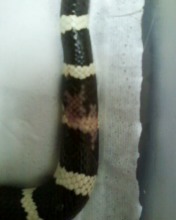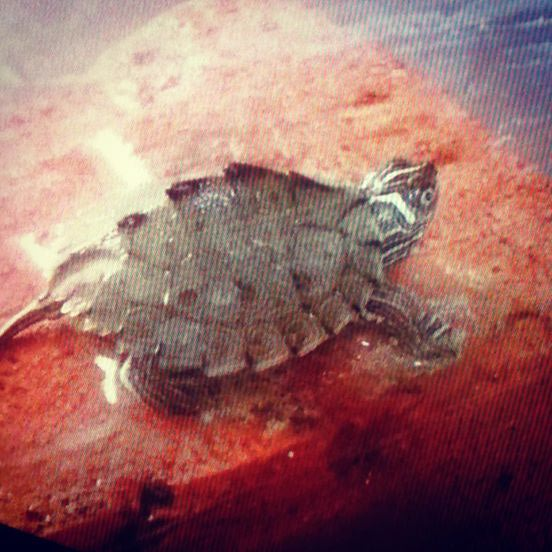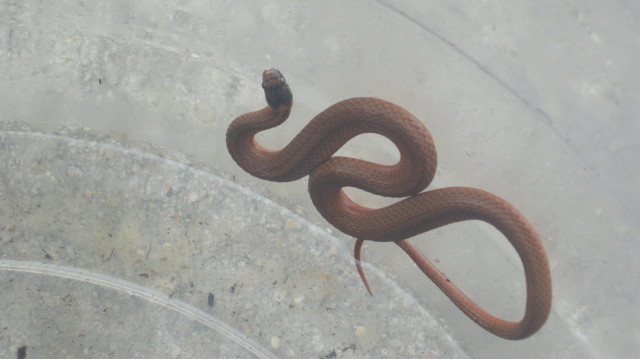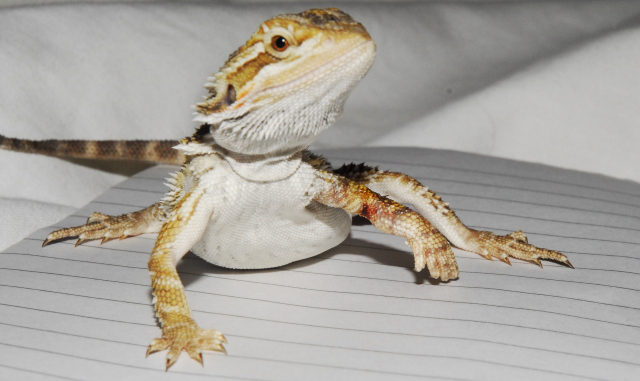QuestionHi there. I have a 6 wk old bearded dragon which I purchased from a local pet shop. At the time we thought the pet shop were highly trustworthy. However we have since discovered the route of our beardies illness. At the pet shop he was kept on calci sand, had no uvb lighting, was being fed crickets bigger than his head and whole lettuce leaves. We got him home and did a lot of research into beardies to ensure we can provide the proper care. Once we discovered the garden centre had neglected his needs we approached them about it but they wouldnt listen. they have a number of reptiles in their care al being kept without any of the proper habitat, food or light source. We are in Scotland and have been trying to see if there is anyone we can report this too to try and prevent any further reptiles being subjected to this neglect. We were wondering if you could advise us on any steps we can take to ensure this stops. I am pleased to say our beardie (Bing) is now no longer impacted after a few warm baths and tummy rubs. He is also become a bit more active although we are having to syringe feed him a baby food/ calcium mixture which was recommended by beardeddragon.org. He has made a great improvement although he is till very weak and doesn't open his eyes very often. We have him in a 3ft viv with a full spectrum basking lamp and a uvb strip light. His basking temp is 100f and the cool end is 80f. He has a reptile radiator to maintain ambient temp. he is unable to reach any of the heat sources. We keep him on sieved play sand and provide fresh daily vegetables which is cut very small.He also has a water bowl which we clean daily to prevent infection. Do you know of anything else we can do to speed his recovery. He is a wonderful little character and a very loved member of our family already and we would hate to lose him.
Any advice would be gratefully appreciated.
Yours Sarah Robertson
AnswerHi Sarah,
I'm including a basic care sheet which I wrote to help ppl out...please pay particular attention to the section on UVB as this is the most current up to date info on some problems that have occurred with particular lights.
Its very common the info the pet store gave you...they generally have no clue as to the care needs of the critters they sell. They are there to sell products...and they house the critters as cheaply as possible to save on their overhead...bad news for the critters and for the people that purchase them as they generally start off with more vet expenses than should be necessary.
Your basking temps need to go up a few degrees...see info below.
I'm glad to hear that the blockage seems to have passed but I would still keep him off sand as its not recommended for babies.
I would be careful with adding the calcium to his feedings unless directed by a vet...be sure the calcium you are using is free of Phosphorus. Also I recommend a vet check for parasites as that nearly ALL reptiles coming from pet stores have internal parasites. The "load" they carry will increase with stress...stress is the conditions they were in at the store and also moving to a new home. Parasites can also cause blockages to form.
Its vital to have the vet do a fecal as that can be a big part of your beardies health problems right now. I also recommend using a product from Pet Authority. Its called Acidopholiz+, which is a probiotic which helps the same as yogurt does a person. In the care sheet below are links to finding vets that are able to treat reptiles.
BASIC BEARDED DRAGON CARE:
HOUSING:
For an adult bearded Dragon, a 50 -55 gallon is the smallest recommended tank. For a baby, nothing less than a 30 gallon tank will work for a very short time, so its best to just start out with the adult sized tank....you can add rocks and branches for climbing, being sure to not stack rocks too high to prevent them toppling over. Branches need to be secure. They like to have a hide log or cave too!! All items brought from outside need to be cleaned well before placing them in the BD's tank. To clean them, there are a few methods: to wash in a bleach solution of 1/4 cup of bleach to 1 gallon of water. Let them soak for about an hour, rinse them in hot water several times and then let them dry in the sun until completely dry. If the items are small enough, they can be baked in an over at 200 degrees for about 2 hours, check often to be sure they are not starting to burn. The items can also be boiled(simmered) for 30 minutes or so and then allowed to dry completely before
placing in the tank. I also suggest washing any pet store items such as caves, rocks, branches, etc before placing in the tank as that if the store would happen to have mites they can also be on the items we purchase. Any of the above methods are acceptable for cleaning. CAUTION!!! On store bought branches...be VERY careful with the driftwood pieces that have the holes in them!!! Be sure the holes are small as that if the holes are large, the BD MAY be able to get his head in them but not able to get it back out!!! A secure screen top is necessary for bearded dragons as that also they do not require much height for climbing..they can and do climb!! NEVER USE HEAT ROCKS OR HEATED CAVES!!! They malfunction and cause severe burns and even death!!!!
SUBSTRATES:
Young bearded dragons MUST be kept on paper towels, newspaper or other non particulate(loose) substrate to prevent them from getting any loose substrate into their mouth and swallowing it which can and does cause intestinal blockages.Once the BD is over 10 inches, some people have had good luck using play sand mixed with 50% of peat moss. I prefer the safe substrate of the newspaper, or other non particulate substrate to prevent any problems and also for ease of cleaning.
LIGHTING:
BD's need UVB, which is the special lights that come in fluorescent tubes or special screw in bulbs
(mercury vapor)that are designed to produce uvb and heat. The tubes do not produce heat. UVB is needed by the BD
to be able to absorb the calcium in the foods they eat. Without the uvb, they will develop metabolic bone disease.
With the tubes, they must say that they produce BOTH uvb and uva. The uvb needs to be 5% or higher. Repti Sun 5.0 and 10.0(not compact) are TWO of the best uvb tubes on the market. The repti glo 8.0's are a great uvb source also. Arcadia 5.0 (UK), which is the uvb tube available in the UK is a good uvb tube. These need to be positioned 6-8 inches(for the 5.0 and 8.0 and 8-10 inches for the 10.0) over the BD so that they get the uvb that is needed. Recommended length of the tube is 24 inches or more. They need to be replaced every 6-9 months as that they stop producing uvb long before they stop producing light. They need to have access to uvb and basking temperatures for 10-12 hours daily. At night, no white lights!!! There has been new studies that have proven that compact uvb lights, both the spiral/coil type and the ones that look like long "U's" laying on their side and a few other brands are causing what basically amounts to snow blindness in reptiles. To read more on this, you can go to
http://www.uvguide.co.uk/index.htm Here is a link to a letter from RZilla on their product: http://www.zilla-rules.com/assets/006/13278.pdf
There are tubes and bulbs that say ''full spectrum'' but they do not produce any uvb.
On the mercury vapor , they also produce heat. They also produce the uvb and uva. The best on the market now are the
MEGA RAY or the T-Rex. www.reptileuv.com has more information on the Mega Ray lights. When using these, the distance is much greater
than the uvb tubes and the directions must be followed that
are listed for the light. When using the mercury vapor
lights, you don't need to have one light for uvb and one for
heat. The Mercury vapor lights provide both.
HEATING AND TEMPERATURES:
Bearded Dragons have specific temperature requirements. For heat when using the uvb producing fluorescent tubes, a regular household lightbulb will work for DAYTIME heat. The wattage needed will vary to each situation such as tank size, room temperatures, air flow. Their basking area temperature must be between 95F and 105F degrees to allow proper digestion of food. Your basking area must be where the uvb light is as well as the heat source. Be sure that the BD cannot get too close to the heat source as that they WILL get burned! The ambient temperature range in the mid 80's . Cool daytime range of normal room temperature of low to mid 70's. Nighttime temperatures in the low to mid 60's is fine. NEVER USE HEAT ROCKS!!!!!!!!!!!!!!!!!!!!! A good digital thermometer is a must. I like using the duel ones with the probe...cost about 15$ at Wal Mart. The probe can be placed in the basking area at the BD's level to monitor this temperature and the main unit can be placed in one of the ambient temperature areas. When reading them, the "out" reading is the probe area.
DIET:
Bearded Dragons eat and need both animal proteins and vegetable matter!!! As young dragons they eat a bit more of the insects. As they get older, as adults their diet is more of the vegetable matter. As young BDs, the diet is about 80% animal proteins and 20% vegetable matter. As they get older, the ratio changes. An adult will eat about 80%-90% vegetable matter and 10-20% animal proteins.
Animal protein sources are: Crickets, superworms, silkworms, roaches, hornworms, waxworms. Waxworms are considered candy to a BD so only feed on occasion in a small amount(2-3 worms). ALL insects must be properly gutloaded for at least 48 hours prior to feeding to the dragon. For crickets and superworms, this can be done with vegetables, plain cereals and commercial foods for the species. Silkworms and the other insects have their own diet needs. Its best to feed the crickets in a separate feeding tank such as a 10 or 20 gallon size tank or container with a well vented lid. This can make it easier for the dragon to catch the crickets and prevents any stray crickets in their "home" tank from deciding to nibble on the BD if he happens to not find them all. If you do feed in his home tank, be sure to place a 1/2 potato in the tank to help prevent the crickets from biting at the BD.
ALL insects fed must be no larger than the space between their eyes to prevent choking. Be sure to dust the insects daily(for dragons up to 14-15 inches) (2x wkly there after)with a good calcium source such as Rep Cal calcium powder with no added Phosphorus. Young BD's up to 4 months of age will eat more crickets than anything. At this age they will usually consume anywhere from 10 to 30+ correctly sized crickets three times a day. Be sure to remove any uneaten crickets that are not consumed in a 15-25 minute time frame. For this reason, its easier to use a separate feeding tank for the bearded dragon. A 10 gallon tank(with a screen top) works well. Its best to offer their "salad" of greens/veggies before offering their morning insect feeding when they are hungry to prevent any problems with them preferring NOT to eat their salad. Their salad consists of Collard greens, mustard greens, turnip greens, dandelion greens...... this is the BASE of the green part of their vegetable diet. To this, for variety you can add arugula, escarole, endive,small amounts of bok choy or other Asian greens. For the vegetable part of the diet, green beans, butternut squash, acorn squash(other winter squashes are also acceptable) yams, sweet potato. For color, sweet peppers can also be added in a small amount. For baby BD's, using a food processor for the greens and veggies works well. As they get older, greens should never be larger than about an inch x an inch in size. Never feed lettuces as they have no nutritional value. The hard veggies should be either food processed or grated. Fruits can also be offered in small amounts. Good fruits are figs, papaya, melon, blueberries, strawberries, raspberries....and many other fruits... these need to be mashed or chopped. Watermelon is a good source of water for the dragon. Their salad can be dusted once or at the most, twice a month with a good vitamin supplement such as RepCal HerptiVit. This is by no means a complete list of foods the dragons can eat.
You can also offer baby food chicken or small bits of boiled chicken.
Be sure to provide a dish of FRESH drinking water at ALL times!!! Misting their salad will also help get much needed water into them. NEVER FEED any MICE or other mammals to your Dragon!!!
WATER:
As stated above, always provide a dish of drinking water and mist their salad. You can also bathe your dragon a few times a week. (many bathe them daily for "bathroom duties") Temperature of the water should be between 85 and 95 degrees. The depth should never be any deeper than to cover his back when laying FLAT!!! Never leave them unattended at bath time to prevent possible drowning. Many love to soak and swim for 15 minutes or more. Never bathe less than two hours before his basking lights go out. Doing so can cause him to become too chilled, risking the chance of a respiratory infection.
A vet check up is recommended and a fecal sample taken in to be tested for any internal parasites.... To find a qualified vet in your area you can go to
http://www.anapsid.org/vets/
http://www.arav.org/Directory.htm
More in-depth care info can be found at:
http://www.bio.miami.edu/ktosney/file/BDcare.html
http://www.sundialreptile.com/care%20sheet--bearded%20dragon.htm
http://www.blackninjakitty.com/herps/dragons
Most bearded dragons will take long naps (generally,if they are over a yr) in the fall.. this is called Brumation. is a form of hibernation. You can read more about that at http://www.bio.miami.edu/ktosney/file/BDbrumate.html

 tea tree oil
QuestionQUESTION: I have a baby California king snake,
tea tree oil
QuestionQUESTION: I have a baby California king snake,
 Female beardie
Question
Igor
Hi there,
Can it be detrimental for my fe
Female beardie
Question
Igor
Hi there,
Can it be detrimental for my fe
 UV light vs LED light
QuestionQUESTION: I have an Wichita Map Turtle,(Though
UV light vs LED light
QuestionQUESTION: I have an Wichita Map Turtle,(Though
 Can you identify this snake?
Question
Snake
Yesterday we found 2 snake sin our pool,
Can you identify this snake?
Question
Snake
Yesterday we found 2 snake sin our pool,
 Baby beardy has broken arm
Questionshe still climbs but t
QUESTION: i hatch
Baby beardy has broken arm
Questionshe still climbs but t
QUESTION: i hatch